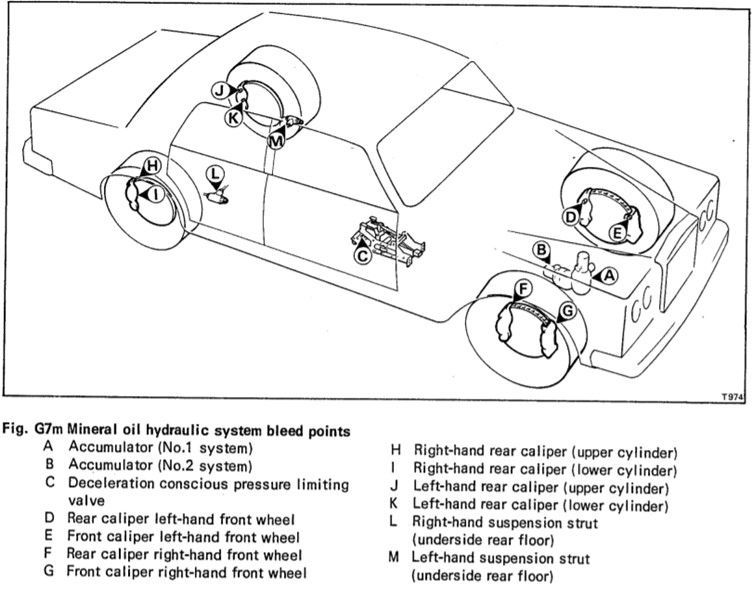This information can be found in the Workshop Manual, TSD4200 section G4M. Please do not attempt any work on the hydraulic system without reading or being able to refer to this manual.
Step-By-Step Procedure (2 Persons Required)
Procedure to De-pressurise the system
Step 1. Put the gear-lever into park ‘P’ position and apply the parking brake, remove the gearchange thermal cut-out from the fuse board.
Switch on the ignition BUT DO NOT start the engine, pump the brake pedal 50 to 60 times until the 2 warning lights ‘1 Brake Pressure’ and ‘2 Brake Pressure’ are illuminated, to de-pressurise the rear struts/dampers attach a bleed tube to each rear strut/damper bleed screw (Bleed points L & M in Fig. G7m) and bleed in turn until the fluid stops flowing and then close the bleed screws.

Step 2. Open the bleed screws at points A and B on the accumulator bodies, do not attach a bleed tube as these bleed ‘internally’, start and run the engine at 1500rpm for 1 minute and ensure that the ‘1 Brake Pressure’ and ‘2 Brake Pressure’ warning lights are illuminated on the dashboard, switch of the engine and close bleed screws A and B.
Step 3. Attach bleed tubes to bleed screws C, D and E and depress the brake pedal. Start and run the engine at 1000rpm and allow points C, D & E to bleed until free of air.
Step 4. Attach bleed tubes to bleed screws F and G and allow bleeding to start, close bleed screws C, D and E, allow bleed screws F and G to bleed until free of air.
Step 5. Attach bleed tubes to bleed screws H and I and allow bleeding to start and close bleed screws F and G, allow bleed screws H and I to flow until free of air.
Step 6. Attach bleed tubes to bleed screws J and K and open the bleed screws and allow to bleed until free of air, close bleed screws H and I.
Step 7. Close bleed screws J and K once free of air and release the brake pedal.
Step 8. With the car on the floor, add weight to the rear of the car (have your assistant sit in the rear of the car or in the boot/trunk to activate the self-levelling system, allow the systems to pressurise (indicated by both dashboard warning lights being extinguished).
Step 9. Attach bleed tubes to bleed screws L and M and allow to bleed until free of air, close bleed screws.
Step 10. Check fluid levels in the reservoirs and top-up as necessary, switch off the engine.
Step 11. Make sure all the bleed screws have had their rubber dust caps re-fitted.
